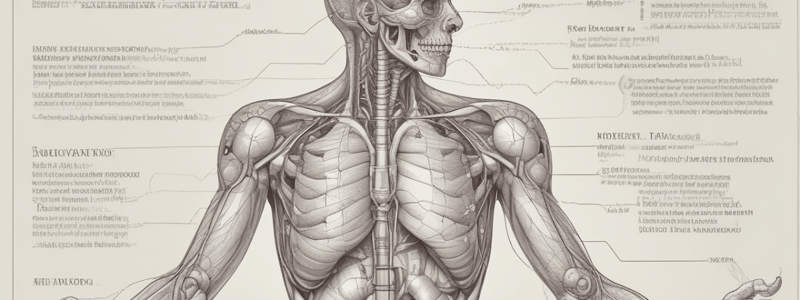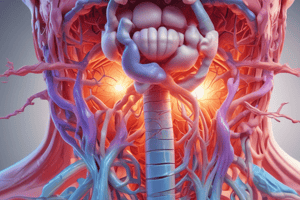Podcast
Questions and Answers
Which muscle is covered by the fascia that forms the lateral arcuate ligament?
Which muscle is covered by the fascia that forms the lateral arcuate ligament?
- Psoas major
- Quadratus lumborum (correct)
- Diaphragm
- Erector spinae
What is the effect of the diaphragm's descent on the intra-thoracic and intra-abdominal pressures?
What is the effect of the diaphragm's descent on the intra-thoracic and intra-abdominal pressures?
- Decreases both intra-thoracic and intra-abdominal pressures
- Decreases intra-thoracic pressure and increases intra-abdominal pressure (correct)
- Increases intra-thoracic pressure and decreases intra-abdominal pressure
- Increases both intra-thoracic and intra-abdominal pressures
Which of the following structures passes through the esophageal opening of the diaphragm?
Which of the following structures passes through the esophageal opening of the diaphragm?
- Esophageal branch of the left gastric vessels (correct)
- Aorta
- IVC
- Thoracic duct
What is the main function of the diaphragm as a muscle of abdominal straining?
What is the main function of the diaphragm as a muscle of abdominal straining?
Which of the following is a function of the diaphragm during weight lifting?
Which of the following is a function of the diaphragm during weight lifting?
What is the level of the vertebral column where the medial arcuate ligament extends from?
What is the level of the vertebral column where the medial arcuate ligament extends from?
Which of the following structures does the diaphragm not relate to superiorly?
Which of the following structures does the diaphragm not relate to superiorly?
What is the origin of the right crus of the diaphragm?
What is the origin of the right crus of the diaphragm?
What is the function of the median arcuate ligament?
What is the function of the median arcuate ligament?
Which of the following structures is NOT related to the diaphragm inferiorly on the left side?
Which of the following structures is NOT related to the diaphragm inferiorly on the left side?
What is the insertion of the sternal part of the diaphragm?
What is the insertion of the sternal part of the diaphragm?
What is the lateral arcuate ligament a part of?
What is the lateral arcuate ligament a part of?
Which of the following nerves pierces the left dome of the diaphragm?
Which of the following nerves pierces the left dome of the diaphragm?
What is the arterial supply of the diaphragm?
What is the arterial supply of the diaphragm?
Which of the following is NOT a weak point of the diaphragm?
Which of the following is NOT a weak point of the diaphragm?
Which of the following nerves provides sensory innervation to the central part of the diaphragm?
Which of the following nerves provides sensory innervation to the central part of the diaphragm?
Which of the following hernias occurs posteriorly?
Which of the following hernias occurs posteriorly?
What is the motor innervation of the diaphragm?
What is the motor innervation of the diaphragm?
Which of the following structures passes posterior to the medial arcuate ligament?
Which of the following structures passes posterior to the medial arcuate ligament?
What is the location of the superior epigastric vessels?
What is the location of the superior epigastric vessels?
Flashcards
Diaphragm's structure
Diaphragm's structure
Peripheral muscular part and central tendinous part.
Diaphragm's muscle origins
Diaphragm's muscle origins
Sternal, costal, and posterior vertebral (lumbar).
Aortic opening contents
Aortic opening contents
Aorta, thoracic duct, and azygos vein.
Esophageal opening contents
Esophageal opening contents
Signup and view all the flashcards
Caval opening contents
Caval opening contents
Signup and view all the flashcards
Diaphragm motor innervation
Diaphragm motor innervation
Signup and view all the flashcards
Diaphragm sensory innervation
Diaphragm sensory innervation
Signup and view all the flashcards
Diaphragm arterial supply
Diaphragm arterial supply
Signup and view all the flashcards
Diaphragm during inspiration
Diaphragm during inspiration
Signup and view all the flashcards
Diaphragm during weight lifting
Diaphragm during weight lifting
Signup and view all the flashcards
Diaphragm during abdominal straining
Diaphragm during abdominal straining
Signup and view all the flashcards
Diaphragm as a thoraco-abdominal pump
Diaphragm as a thoraco-abdominal pump
Signup and view all the flashcards
Bochdalek's hernia
Bochdalek's hernia
Signup and view all the flashcards
Morgagni hernia
Morgagni hernia
Signup and view all the flashcards
Superior relations of the diaphragm
Superior relations of the diaphragm
Signup and view all the flashcards
Inferior relations of the diaphragm
Inferior relations of the diaphragm
Signup and view all the flashcards
Study Notes
Diaphragm Structure
- The diaphragm is divided into a peripheral muscular part and a central tendinous part.
- The muscle fibers of the diaphragm arise from three parts: sternal, costal, and posterior vertebral or lumbar.
- The sternal part originates from the post surface of the xiphoid process and inserts into the central tendon.
- The costal part originates from the lower 6 ribs and costal cartilages and inserts into the central tendon.
- The posterior vertebral or lumbar part is divided into right and left crus, medial arcuate ligament, and lateral arcuate ligament.
Openings of the Diaphragm
- The diaphragm has several openings, including:
- Aortic opening (T12): aorta, thoracic duct, and azygos vein
- Esophageal opening (T10): esophagus, left and right vagus nerve, esophageal branch of left gastric vessels, and lymphatics from lower 1/3 of esophagus
- Caval opening (T8): IVC, terminal branch of right phrenic nerve, and additional greater splanchnic nerve, lesser splanchnic nerve, and lowest splanchnic nerve
Innervation and Arterial Supply of the Diaphragm
- Motor innervation: phrenic nerves (C3, 4, 5)
- Sensory innervation: peripheral part (intercostal nerves T5-T11) and central part (phrenic nerve C3, 4, 5)
- Arterial supply: superior phrenic artery (branch of descending aorta), inferior phrenic artery (branch of abdominal aorta), pericardiacophrenic artery (branch of internal thoracic artery), and musculophrenic artery (branch of internal thoracic artery)
Actions of the Diaphragm
- Muscle of inspiration: pulls the central tendon down, increasing the vertical diameter
- Weight lifting muscle: takes a deep breath and fixes the diaphragm to rise the intra-abdominal pressure and support the vertebral column
- Muscle of abdominal straining: aids the contraction of anterior abdominal wall muscles and rises the intra-abdominal pressure to evacuate the pelvic content
- Thoraco-abdominal pump: descent of the diaphragm decreases the intra-thoracic pressure and increases the intra-abdominal pressure, compressing the blood in the IVC and forcing it upwards
Diaphragmatic Hernias
- Bochdalek's hernia: posterior
- Morgagni hernia: anterior
Relations of the Diaphragm
- Superior relations: pleura, base of the left and right lung, pericardium, and diaphragmatic surface of the heart
- Inferior relations: right lobe of the liver, right kidney, right suprarenal gland, left lobe of the liver, fundus of the stomach, left kidney, left suprarenal gland, and spleen
Studying That Suits You
Use AI to generate personalized quizzes and flashcards to suit your learning preferences.



